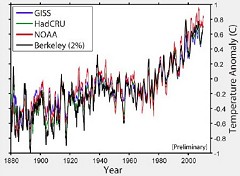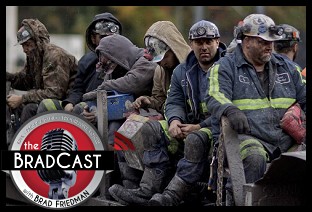PLUS: German study uses French data to corroborate findings from Austrian, U.S. scientists, suggesting Fukushima disaster should be reclassified as 'level 7' accident, on par with Chernobyl...

As we noted was likely to happen just after posting last night's update on the Fukushima Daiichi nuclear disaster, the "calm" over the last day or two that we reported was somewhat broken shortly thereafter. Japan's Prime Minister Naoto Kan took to the air for a rare press conference to discuss the situation at the crippled nuclear plant, and to mark the two weeks which have passed since an unprecedented, three-prong earthquake/tsunami/nuclear disaster rocked the country.
Kan described the situation at Fukushima as "very grave and serious", adding, "we are not in a position where we can be optimistic. We must treat every development with the utmost care."
He did not, however, offer much in the way of new information. In the meantime, other government officials have now recommended (but not ordered) that those living between 20 and 30 kilometers from the plant voluntarily leave the area. They stress that the new recommendations are due to the difficulty in supplying food and other resources to the area, not because of an increase in radiation levels.
Last week, those living within 20 kilometers of the plant were forced to evacuate from that "exclusion zone", and those within 20 to 30km of the plant were instructed to stay indoors to avoid radioactive fallout. The U.S. government has recommended a larger exclusion zone of 80 kilometers (50 miles) around the plant, though Japan has not felt it necessary to widen their own mandatory exclusion zone.
 The most noteworthy hard news development since our report yesterday is the speculation --- and yes, we'll still call it speculation until there is hard confirmation --- that the containment vessel at Unit 3 has ruptured in some fashion, and that a meltdown may be occurring in the core of the reactor. Those details seem to be largely speculative still at this hour, based on the investigation into what caused the water at the reactor building to be as radioactive as it was to lead to "beta burns" on the feet and ankles of three workers yesterday who stepped in water while trying to restore electricity to the unit. Two of them were hospitalized. (See dispiriting photo at top of this article.)
The most noteworthy hard news development since our report yesterday is the speculation --- and yes, we'll still call it speculation until there is hard confirmation --- that the containment vessel at Unit 3 has ruptured in some fashion, and that a meltdown may be occurring in the core of the reactor. Those details seem to be largely speculative still at this hour, based on the investigation into what caused the water at the reactor building to be as radioactive as it was to lead to "beta burns" on the feet and ankles of three workers yesterday who stepped in water while trying to restore electricity to the unit. Two of them were hospitalized. (See dispiriting photo at top of this article.)
Whether the extraordinarily high levels of radiation in the water is coming from a crack in the steel containment vessel housing the reactor core there, or from water leaking out of the spent fuel pool at Unit 3 --- or even from something else --- doesn't seem to be conclusively known at this point. But the radiation in the water was reportedly 10,000 times the "normal" limit, with some reports pegging the radiation at 100,000 times higher.
That's not the only disturbing news, however, as we now have more scientists ringing in on the data we discussed in detail yesterday from Austrian researchers suggesting that some 50% of the radioactive cesium-137 that spewed from Chernobyl in 1986 has already been emitted to surrounding areas in Japan from one or more of the crippled reactors at Fukushima...
--- Click here for REST OF STORY!... ---
 If you’re a climate hawk, or even a climate hobbyist, this graph should look familiar --- it’s the warming trend over the last 100-odd years. Except the guy who busted this out at the House climate science hearing yesterday was brought in by the Republicans to debunk global warming. (The black line is his data.) Haha, whoops!
If you’re a climate hawk, or even a climate hobbyist, this graph should look familiar --- it’s the warming trend over the last 100-odd years. Except the guy who busted this out at the House climate science hearing yesterday was brought in by the Republicans to debunk global warming. (The black line is his data.) Haha, whoops!


 Campaign to 'Impeach Trump Again' Gains Fresh Momentum: 'BradCast' 4/29/25
Campaign to 'Impeach Trump Again' Gains Fresh Momentum: 'BradCast' 4/29/25 'Green News Report' 4/29/25
'Green News Report' 4/29/25
 And Then They Came for the Judges...: 'BradCast' 4/28/25
And Then They Came for the Judges...: 'BradCast' 4/28/25 Sunday 'Desperation' Toons
Sunday 'Desperation' Toons Trump EPA Guts Enviro Justice Office: 'BradCast' 4/24/25
Trump EPA Guts Enviro Justice Office: 'BradCast' 4/24/25 'Green News Report' 4/24/25
'Green News Report' 4/24/25 Nation's Largest Broadcaster Hoaxes Viewers to Help Gut FCC Rules: 'BradCast' 4/23/25
Nation's Largest Broadcaster Hoaxes Viewers to Help Gut FCC Rules: 'BradCast' 4/23/25 Trump's FCC on Precipice of Ending All Limits on Corporate Control of Local TV Stations
Trump's FCC on Precipice of Ending All Limits on Corporate Control of Local TV Stations GOP Earth Day 2025 Hypocrisies and Dilemmas: 'BradCast' 4/22/25
GOP Earth Day 2025 Hypocrisies and Dilemmas: 'BradCast' 4/22/25 'Green News Report' 4/22/25
'Green News Report' 4/22/25 Pope Francis Dies, Trump Still Alive and Criming: 'BradCast' 4/21/25
Pope Francis Dies, Trump Still Alive and Criming: 'BradCast' 4/21/25 Sunday
Sunday  Sunday 'Zero Day' Toons
Sunday 'Zero Day' Toons 'Green News Report' 4/10/25
'Green News Report' 4/10/25 Soc. Sec. Expert Warns DOGE of Collapse, Privatization: 'BradCast' 4/10/2025
Soc. Sec. Expert Warns DOGE of Collapse, Privatization: 'BradCast' 4/10/2025 Trump Blinks, Chaos Reigns, Markets Spike Amid Tariff 'Pause': 'BradCast' 4/9/25
Trump Blinks, Chaos Reigns, Markets Spike Amid Tariff 'Pause': 'BradCast' 4/9/25 SCOTUS Deportation Ruling Grimmer Than First Appears: 'BradCast' 4/8/25
SCOTUS Deportation Ruling Grimmer Than First Appears: 'BradCast' 4/8/25 Cliff Diving with Donald: 'BradCast' 4/7/25
Cliff Diving with Donald: 'BradCast' 4/7/25 'Mob Boss' Trump's Trade Sanctions Tank U.S., World Markets: 'BradCast' 4/3/25
'Mob Boss' Trump's Trade Sanctions Tank U.S., World Markets: 'BradCast' 4/3/25 Crawford Landslide in WI; Booker Makes History in U.S. Senate: 'BradCast' 4/2/25
Crawford Landslide in WI; Booker Makes History in U.S. Senate: 'BradCast' 4/2/25 Judge Ends Challenge to GA's Unverifiable, Insecure Vote System: 'BradCast' 4/1/25
Judge Ends Challenge to GA's Unverifiable, Insecure Vote System: 'BradCast' 4/1/25 Bad Court, Election News for Trump is Good News for U.S.: 'BradCast' 3/31
Bad Court, Election News for Trump is Good News for U.S.: 'BradCast' 3/31
 VA GOP VOTER REG FRAUDSTER OFF HOOK
VA GOP VOTER REG FRAUDSTER OFF HOOK Criminal GOP Voter Registration Fraud Probe Expanding in VA
Criminal GOP Voter Registration Fraud Probe Expanding in VA DOJ PROBE SOUGHT AFTER VA ARREST
DOJ PROBE SOUGHT AFTER VA ARREST Arrest in VA: GOP Voter Reg Scandal Widens
Arrest in VA: GOP Voter Reg Scandal Widens ALL TOGETHER: ROVE, SPROUL, KOCHS, RNC
ALL TOGETHER: ROVE, SPROUL, KOCHS, RNC LATimes: RNC's 'Fired' Sproul Working for Repubs in 'as Many as 30 States'
LATimes: RNC's 'Fired' Sproul Working for Repubs in 'as Many as 30 States' 'Fired' Sproul Group 'Cloned', Still Working for Republicans in At Least 10 States
'Fired' Sproul Group 'Cloned', Still Working for Republicans in At Least 10 States FINALLY: FOX ON GOP REG FRAUD SCANDAL
FINALLY: FOX ON GOP REG FRAUD SCANDAL COLORADO FOLLOWS FLORIDA WITH GOP CRIMINAL INVESTIGATION
COLORADO FOLLOWS FLORIDA WITH GOP CRIMINAL INVESTIGATION CRIMINAL PROBE LAUNCHED INTO GOP VOTER REGISTRATION FRAUD SCANDAL IN FL
CRIMINAL PROBE LAUNCHED INTO GOP VOTER REGISTRATION FRAUD SCANDAL IN FL Brad Breaks PA Photo ID & GOP Registration Fraud Scandal News on Hartmann TV
Brad Breaks PA Photo ID & GOP Registration Fraud Scandal News on Hartmann TV  CAUGHT ON TAPE: COORDINATED NATIONWIDE GOP VOTER REG SCAM
CAUGHT ON TAPE: COORDINATED NATIONWIDE GOP VOTER REG SCAM CRIMINAL ELECTION FRAUD COMPLAINT FILED AGAINST GOP 'FRAUD' FIRM
CRIMINAL ELECTION FRAUD COMPLAINT FILED AGAINST GOP 'FRAUD' FIRM RICK SCOTT GETS ROLLED IN GOP REGISTRATION FRAUD SCANDAL
RICK SCOTT GETS ROLLED IN GOP REGISTRATION FRAUD SCANDAL VIDEO: Brad Breaks GOP Reg Fraud Scandal on Hartmann TV
VIDEO: Brad Breaks GOP Reg Fraud Scandal on Hartmann TV RNC FIRES NATIONAL VOTER REGISTRATION FIRM FOR FRAUD
RNC FIRES NATIONAL VOTER REGISTRATION FIRM FOR FRAUD EXCLUSIVE: Intvw w/ FL Official Who First Discovered GOP Reg Fraud
EXCLUSIVE: Intvw w/ FL Official Who First Discovered GOP Reg Fraud GOP REGISTRATION FRAUD FOUND IN FL
GOP REGISTRATION FRAUD FOUND IN FL



















 You really can get anything on EBay, even electronic voting machines proved to be easy to corrupt for purposes of voting fraud.
You really can get anything on EBay, even electronic voting machines proved to be easy to corrupt for purposes of voting fraud.


 Rep. John Mica (R-FL), Chair of the House Transportation Committee, inserted union-busting language into the
Rep. John Mica (R-FL), Chair of the House Transportation Committee, inserted union-busting language into the  Today on my Wednesday show on
Today on my Wednesday show on 




 The GOP voter fraud epidemic continues unabated. The latest alleged felon? Outgoing U.S. Ambassador to China, former Utah Governor --- and potential 2012 GOP Presidential candidate --- Jon Huntsman Jr.
The GOP voter fraud epidemic continues unabated. The latest alleged felon? Outgoing U.S. Ambassador to China, former Utah Governor --- and potential 2012 GOP Presidential candidate --- Jon Huntsman Jr.
 Guest blogged by Ernest A. Canning
Guest blogged by Ernest A. Canning
 The most noteworthy hard news development since our report yesterday is the speculation --- and yes, we'll still call it speculation until there is hard confirmation --- that the containment vessel at Unit 3 has ruptured in some fashion, and that a meltdown may be occurring in the core of the reactor. Those details seem to be largely speculative still at this hour, based on the investigation into what caused the water at the reactor building to be as radioactive as it was to lead to "beta burns" on the feet and ankles of three workers yesterday who stepped in water while trying to restore electricity to the unit. Two of them were hospitalized. (See dispiriting photo at top of this article.)
The most noteworthy hard news development since our report yesterday is the speculation --- and yes, we'll still call it speculation until there is hard confirmation --- that the containment vessel at Unit 3 has ruptured in some fashion, and that a meltdown may be occurring in the core of the reactor. Those details seem to be largely speculative still at this hour, based on the investigation into what caused the water at the reactor building to be as radioactive as it was to lead to "beta burns" on the feet and ankles of three workers yesterday who stepped in water while trying to restore electricity to the unit. Two of them were hospitalized. (See dispiriting photo at top of this article.)













